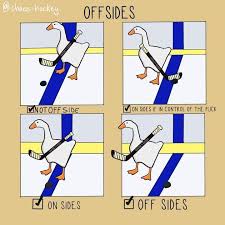Offside in Hockey: Unraveling the Mystery for Casual Fans
Imagine you’re at a hockey game, the excitement is palpable, and your team is rushing down the ice, poised for a thrilling goal. Just as the puck crosses into the attacking zone, the referee’s whistle pierces through the air, halting the play. “Offside,” they declare, and the crowd groans. You’re not alone if you’ve ever found yourself confused by this sudden interruption. Offside in hockey can be a perplexing rule for casual fans, but fear not! We’re here to demystify it and help you recognize an offside before the referee even blows the whistle.
What is Offside in Hockey?
At its core, the offside rule in hockey is designed to ensure fair play and prevent teams from gaining an unfair advantage by “cherry-picking” near the opponent’s goal. It ensures that the game remains competitive and fluid, but understanding its intricacies can be challenging. Here’s a straightforward explanation:

The Rule: A player is considered offside if they enter the attacking zone (the area between the opponent’s blue line and goal line) before the puck does. To be onside, both skates of the player must be completely outside the attacking zone (i.e., not touching or over the blue line) until the puck crosses the blue line.
Recognizing Offside: Tips for Casual Fans
- Watch the Blue Line: The blue lines on the rink are your key indicators. When a player from the attacking team approaches the opponent’s zone, make sure the puck crosses the blue line first. If any player enters the zone before the puck, it’s offside.
- Focus on the Puck Carrier: Keep an eye on the player with the puck. As they approach the blue line, check where their teammates are. If a teammate crosses the blue line before the puck does, the play is offside.
- Referee Positioning: Often, referees will position themselves along the blue line to get a clear view of potential offsides. If you notice the referee in this position and see them raise their arm, an offside call might be imminent.

Why Offside Matters
Understanding offside is crucial not just for grasping the flow of the game, but also for appreciating the strategic elements that teams employ. Coaches and players meticulously plan their entries into the attacking zone, timing their movements to perfection. Recognizing offside can enhance your enjoyment of the game by giving you insight into these strategies and making those game-stopping whistles less frustrating.
Keep An Eye On The Blue Line
Offside may seem like a small detail in the fast-paced, hard-hitting world of hockey, but it plays a significant role in maintaining the integrity and excitement of the game. By keeping an eye on the blue line and the puck, you’ll soon be able to anticipate offside calls with ease. So next time you hear that whistle, you’ll know exactly why the play was stopped, and you might even find yourself nodding along with the call, impressing your fellow fans with your newfound knowledge.
[uap-landing-commission slug=’author_1′]
















+ There are no comments
Add yours